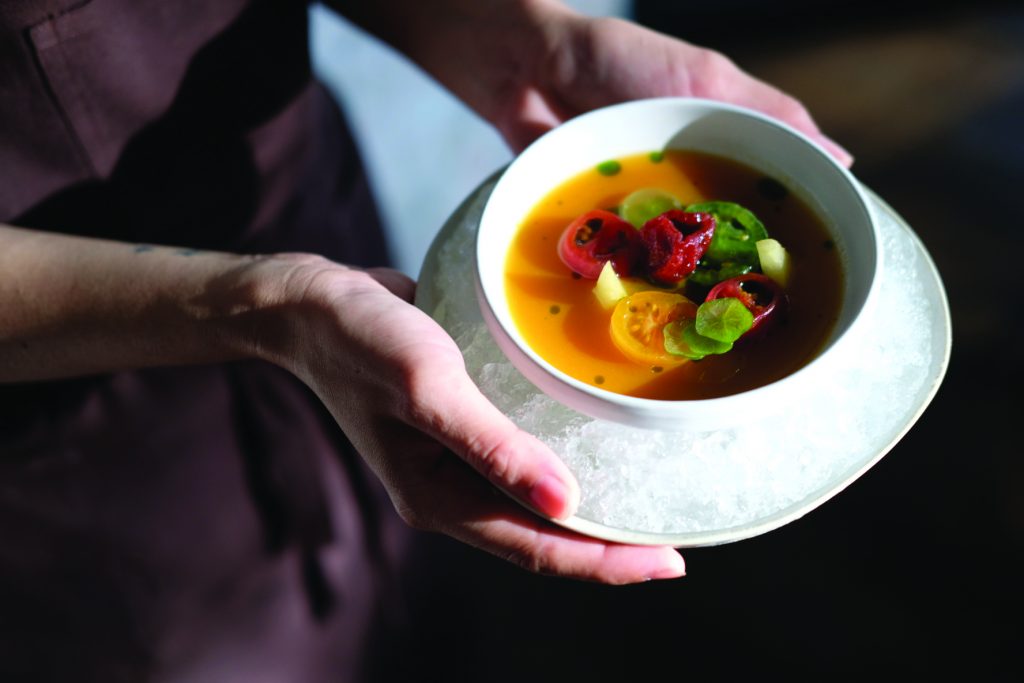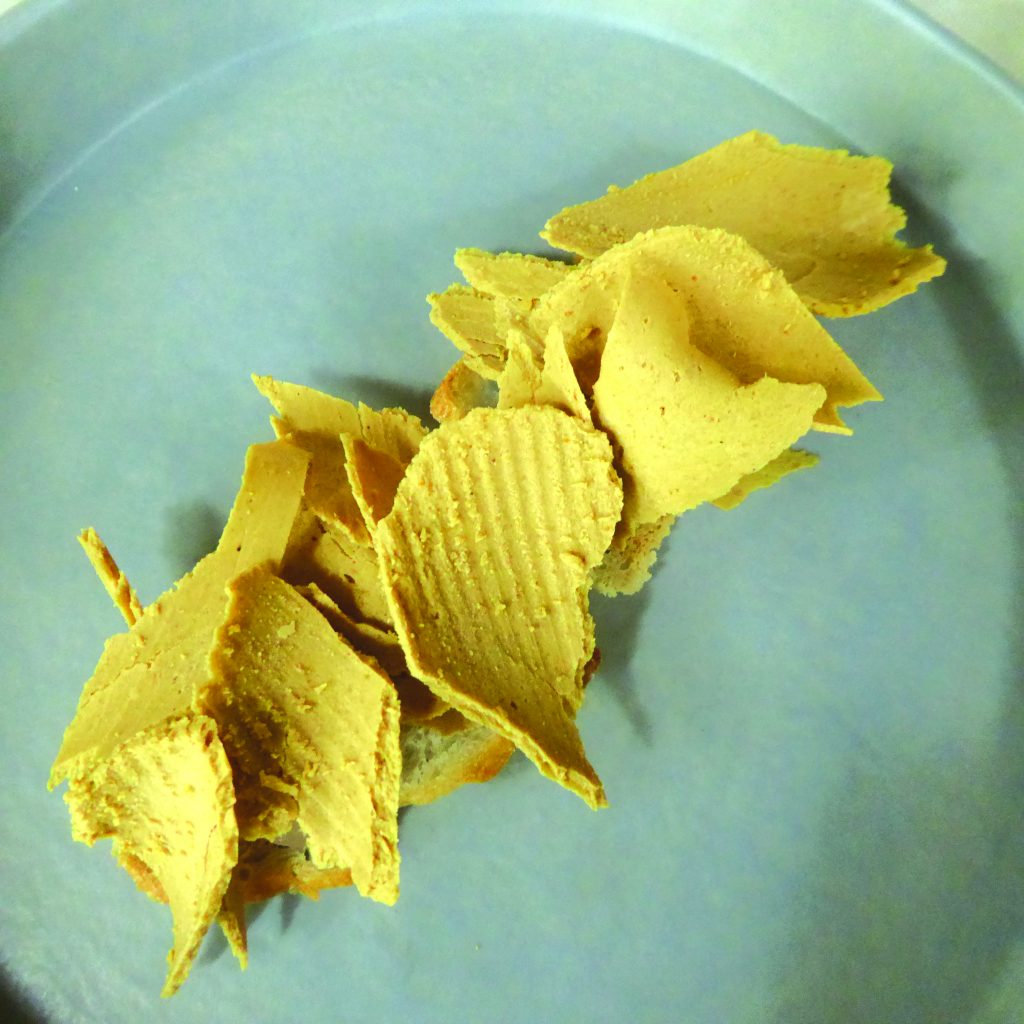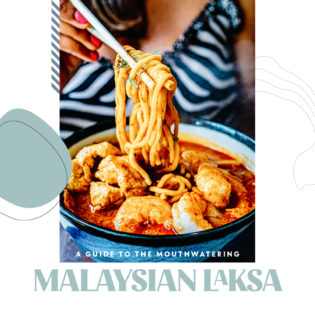It’s plain to see why Garima Arora has been showered with accolades for her first restaurant Gaa.
Photography courtesy of Gaa

Chef Garima Arora didn’t come to Bangkok to open a restaurant. She studied at the Cordon Bleu in Paris and held several jobs, including a career-defining two-year stint at Noma in Copenhagen, where Arora was hand-picked by culinary powerhouse Gaggan Anand to head his flagship Indian restaurant in India. The Mumbai native joined Gaggan’s eponymous restaurant in Bangkok to prepare for the new project, but the plan fizzled before it ever got off the ground.
Arora found herself in a country with which she discovered a surprisingly deep affinity. “In India, we have a very superficial view of what Thailand is” – a view that she shared at the time. But she observes, “There is a strong connection between Thailand and India culturally. The people, the history, are very similar. There are so many words that are similar to Hindi.”
With that connection, the idea to stay in Bangkok seemed like a perfectly natural choice to her. “I think Thailand makes a good backdrop to work with Indian cuisine,” she says. She fell in love with local ingredients, from egg fruit to greens foraged in the jungle. “I think my pivotal point was meeting Num,” she said, using the nickname of Chef Weerawat Triyasenawat of Samuay and Sons in Udon Thani in northeastern Thailand, known for his creative use of foraged ingredients. “Seeing all these ingredients made me change my whole idea about whether I could live here and work here.” She concedes that would be the case no matter where she was cooking. “If I were in another part of the world, I would do just that, work with what’s around me.”

She moved into a couple of shophouses opposite Gaggan’s restaurant and had free rein to design her restaurant from the ground up. Among other techniques, she embraced fermentation, one of the signatures of Noma, as a key to her unique flavour profiles, something she emphasised when Gaa opened its doors two years ago. “We still do. It’s a big part of who we are.”
Arora’s own personality really shines through when she reimagines her Indian heritage. “Indian cuisine can be much more than comfort food. It has the resources to give chefs the means to make something completely new, different and modern.” She doesn’t serve rich gravies and stacks of bread, but rather uses her memories of food from home as a starting point.
She points to the braised jackfruit with pickles, the crayfish head, and her take on a beef taco as examples of dishes that owe a debt to her Indian roots yet are decidedly her own. She also singles out the betel leaf, an ingredient used both in Thai and Indian cuisine, that she uses at the start and end of the meal in original ways.

“They’re like bookends. You start your meal with the savoury betel leaf like you would in Thailand and you finish it sweet like in India. That’s the connection and I think it tells that story beautifully. They are not traditional recipes by any stretch of the imagination, but the reference points are in the cultures.” They are also visually stunning and are among the most photographed of her dishes.

Recognition of her intensely personal work didn’t take long. After just a year and a half, she won a Michelin star, an historic first for a woman from India. “I went from being a line chef to having my own restaurant,” she says, looking across the lane in the direction of Gaggan’s kitchen. Soon after she picked up the star, she received a call from the organisers of Asia’s 50 Best Restaurants saying she had been selected as 2019’s Best Female Chef in Asia. Would she accept the honour?
“I thought about accepting or not,” she says candidly. “I have strong feelings about many issues. I am absolutely against positive discrimination.” She bristles slightly when asked if she sees herself as a role model. In the end, she decided to accept because the exposure gave her a new platform to talk about Indian food in a modern context. In addition to the Best Female Chef award, she also entered the 50 Best list at number 16, the highest new entry this year.

Despite the attention, she is determined to stay focused. She has no plans to expand. “It’s one day at a time,” she states. She also doesn’t want to lose sight of her continued research in the kitchen. Her eyes light up when she takes the example of the humble besan or chickpea flour. “As a starch, there is so much potential. We fry it, we steam it, we poach it. It can be reinterpreted in a modern way.” It’s a challenge she relishes. But she is against changing just for the sake of change. “For me, menu changes only make sense when you have something worthwhile to say.”
She hastens to point out that it hasn’t been all smooth sailing. She has had to learn about managing expectations of partners, staff and customers. She has had to “deal with figures,” she says, rolling her eyes. But the added responsibility has given her focus and grounding. Arora, who also found time to get married while starting a new business, notes with a laugh that “my husband says I’m much more patient since opening the restaurant.”
It’s safe to bet that a besan-based dish will make its way to the menu when she’s ready. “Am I working on it? Yes! Have I got anywhere? No!” But there is no doubt in her voice that she will find a solution. “How else do you push yourself if you don’t look for something new and something different?”

Cook Like A Chef
Chef Arora shares her Spicy Chicken Liver Pâté On Toast.
Ingredients:
- 500g chicken liver
- 250ml milk (or enough to cover the chicken liver)
1-2 curry leaves
1 green chilli, chopped
1 tsp oil
- 1 tbsp butter
- 200g onion, chopped
200g carrot, chopped
100g green apple, chopped
100g celery, chopped
- 1 tbsp Madras curry powder or your own masala
- Salt to taste
- 250gm butter
250ml cream
30ml orange-flavoured liqueur (or substitute orange juice and a little grated orange zest)
- Toasted bread, for serving
- Lychee, longan or other fruit for garnish
Method:
- In a covered bowl, soak the liver in milk. Leave overnight in the refrigerator. This helps get rid of any unpleasant smell or flavour and tenderises the liver.
- In a pan over medium-high heat, add oil. Add green chillies and curry leaves. Lower heat to medium and add butter and chopped fruit and vegetables. Cook until softened. Add salt and spice mix. Make sure not to burn the spice at this point. Once everything is cooked down together, put aside and cool.
- Drain and pat the liver dry. In the same pan, add a generous spoonful of the remaining butter and cook the liver on both sides over medium-high heat till nicely browned. Deglaze the pan with orange-flavoured liqueur or orange juice. Let it reduce to a syrup-like consistency. Remove liver, add cream and reduce the liquid by half and remove from the pan.
- Cool it in a refrigerator.
- Blend vegetables, liver and cooking liquid together with an immersion blender or food processor. Continue blending and gradually add remaining butter (as cold as possible). Strain this purée through a fine sieve. Add salt to taste. Chill thoroughly.
- Enjoy on toast with a sweet and acidic fruit like lychee or longan.









